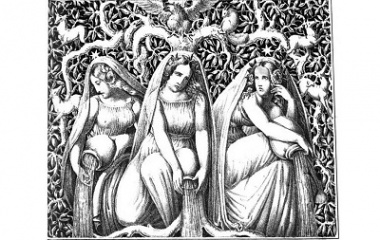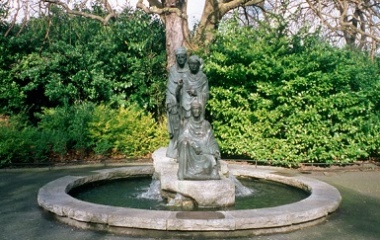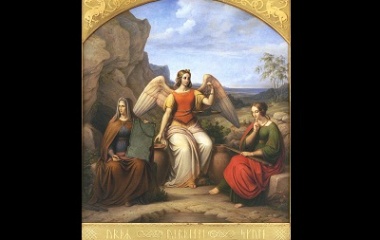- Pronunciation: noh-urn
- Origin: Norse mythology
- Race: Jotun Goddesses
- Famous Norns: Wyrd, Verdandi and Skuld
Have you ever felt like you were meant for some specific purpose? That you had a specific destiny? Well, if you were a believer in Norse mythology, that feeling would be no accident. Both the gods and humans have a fate, and that fate is governed by goddesses known as Norns.
Who Are the Norns?
It’s important to understand that there are Norns with a capital “N” and then there are the more general ones. The word can generally apply to anyone who is a user of magic, but here we’re referring to the main or principal beings with that name: the three known as Wyrd (Urd), Verdandi and Skuld.
They are the caretakers of Yggdrasil. Yggdrasil is the tree that holds the nine worlds of Norse mythology of which the human world, Midgard, is only one.
The Norns take water from the Well of Fates (also known as the Well of Urd) and pour it on the branches of Yggdrasil. In Norse mythology, a key idea is that all things will eventually come to an end. All of existence ends with the Ragnarok. Similarly, even Yggdrasil is going to wither and die, but this care slows that decay down.
The less famous norns are also known for appearing at the birth of humans in order to weave their thread of fate. Some norns cause tragic or bad things to happen and others are like guardian angels, looking out for people. As a group, the norns are neither good nor evil.
The three principle Norns are sometimes said to represent the past, present and future, these being the domain of Urd, Verdandi and Skuld respectively. That is something that is however debated among those people who study Norse mythology.
Appearance
Norns, especially the three principle Norns, are usually depicted as unremarkable human women. Of course, they are in fact giantesses from Jotunheim, the land of giants, but they are often shown at a normal human scale. Sometimes a Norn will have non-human features. For example, Verdandi has been depicted with angelic wings, although this is not considered to be true to the folklore.
Some of the Norns, such as Skuld, have also been shown as Valkyries, wearing armor and flying on the backs of war horses.
Origins
As giants, the Norns hail from Jotunheim, but they reside by the Well of Fate from which Yggdrasil grows. The Well of Fate itself contains the most powerful forces in all of reality and many primordial truths and powers that few can comprehend.
There is some disagreement about where exactly they spend their time. Some say they live under Yggdrasil’s roots. Others say they live over the arch of the Bifrost Bridge. Most agree that the three weave a tapestry of fate and that each string on their loom is the fate of one person, which is then intertwined with all other people to form the overall picture.
As gods that know how to weave and alter the threads of fate, the Norns are very powerful and even command the respect and envy of Odin himself. Apart from their loom and tapestry, the three carve runes into the trunk of Yggdrasil. The meanings of these runes run through Yggdrasil and have an effect on all nine of the worlds in the tree’s branches.
Even the gods have threads of their own in the tapestry, but the three Norns will never let them see them. Only they know what fate has in store for all who live in the cosmos.
History
The three are documented extensively in various sources, although as with most Norse mythology the most important ones are the Prose Edda and Poetic Edda. They also feature in various legendary sagas. As some of the most powerful beings in the cosmos, it stands to reason that many stories from Norse tradition feature Norns, even if only briefly. They are often the reason that something bad happens to the hero.
However, these stories show us that although the pull of fate as controlled by the Norns is strong, humans and gods alike can change their fates. The will of the Norns is not absolute by any means.
The idea of the Norns is similar to, for example, the idea of the three Fates in Greek mythology. The Norns may also have derived from ideas about female supernatural beings and spirits from a more general Germanic background. In particular, the north-west European gods known as the Matres and Matrones bear striking resemblances to the three. The Valkyries may also have been inspired by the same source.
Modern Influence
Norse mythology itself is still very influential in contemporary culture, and since the Norns are such prominent figures within that mythology, they also feature quite often in modern literature and film.
They are also rather well-represented in video games, with titles such as Valkyrie Profile and Shin Megami Tensei containing references to them. These Japanese games are joined by the long running Ah! My Goddess! series which features Skuld, Urd and Verdandi as the main characters.
The witches in Shakespeare’s Macbeth are very clearly Norns as well. Terry Pratchett’s Discworld series also features three witches who are heavily inspired by the three.
The idea of fate being the result of such mysterious and enigmatic beings is one that’s popular across many cultures, but the image of the Norns has endured and wormed itself into global culture.










